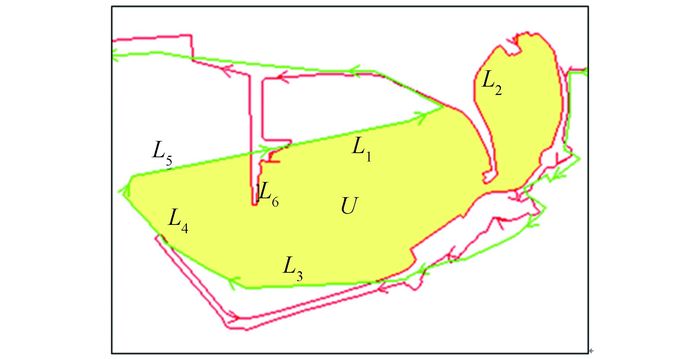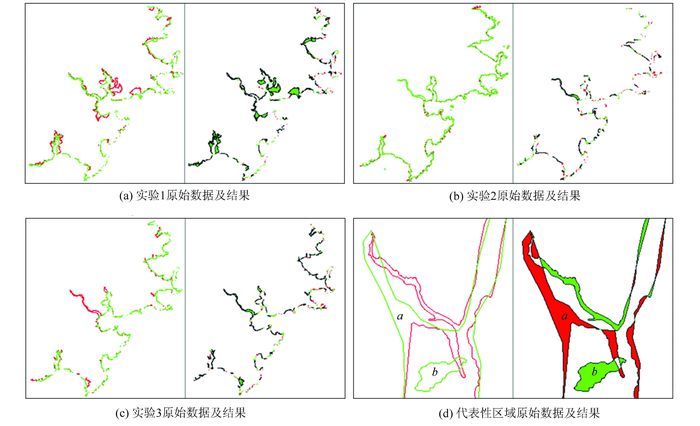-
摘要: 当前对于涉及两个时期间海岸线蚀退型和淤积型区域的构建研究尚缺乏较为自动准确的方法。将两个时期的海岸线视为有向且无自相交的曲线,相互打断为若干有向折线段。通过总结各类型区域边界的构成规律,提出两时期海岸线间变迁区域的自动构建算法。构成变迁区域边界的海岸线折线段总是两个时期间隔出现,且有相同的起点或终点,移除构成某一变迁区域的所有折线段后,对其他区域的提取没有影响。据此规律,提取某一变迁区域边界上的所有折线段,利用其中的点构建区域,根据早期海岸线的方向,判断变迁区域的具体类型。以实际海岸线数据进行验证实验,结果符合预期。该算法可根据两个时期的海岸线,快速准确地提取出由水域变为陆地的淤积型区域和由陆地变为水域的蚀退型区域,为分析海岸线的时空变化特性提供辅助作用。Abstract: There is important theoretical and practical significance to study the change of coastline. Currently, in order to complete coastline analysis work, it is short of the automatic and accurate algorithms which can construct and mark all the changed areas including erosional and increasing types between two period coastlines. We consider that all the coastlines distributed in the two periods have directions which are determined by the order of the points on the coastline, and don't intersect with themselves. Coastlines can only intersect with the ones in the other period which have different direction and will be cut into some polylines. By summarizing the distribution rules of polylines on the boundary of the changed area with different type, we get a number of conclusions and put forward the algorithm which can construct changed areas between two period coastlines automatically and mark them with different type exactly. The coastline polylines constituting edges of changed area always arise a period next to another which has the same start or end point. Removing all the polylines constituting a changed area, it will not affect the others. According to the rules, we can extract the polylines on a changed area's edge and build the area using the points. Judge the type of the changed area by examining the direction of earlier coastline which can be divided into clockwise or anticlockwise. We complete the programming of the function module. Several experiments are designed and implemented with some real coastline data collected in the actual projects. To test the algorithm is reliable or not, we compare the boundary and type of the changed area generated automatically by the algorithms with fact. And the results show that the method is effective and feasible. By our method, the erosional areas which changed into water from land and the accretion areas which changed into land from water can be constructed exactly and automatically according to two period coastlines. This provides assistances for spatial and temporal analysis of coastline change.
-
Keywords:
- coastline /
- coastline change /
- changed area /
- area construction /
- computer application
-
-
表 1 实验参数统计
Table 1 Statistic of Construction Test
参数 实验1 实验2 实验3 早期节点数 11 173 15 092 23 398 晚期节点数 15 092 18 907 14 143 折线段数量 2 792 2 360 4 446 蚀退区数量 601 503 1 017 淤积区数目 603 505 1 022 成区准确率 100% 100% 100% 构建时间/s < 1 < 1 < 1 -
[1] 蔡则健, 吴曙光.江苏海岸线演变趋势遥感分析[J].国土资源遥感, 2002, 53(3):19-23 doi: 10.6046/gtzyyg.2002.03.06 Cai Zejian, Wu Shuguang. Remote Sensing Analysis of the Coastline Development in Jiangsu Province[J]. Remote Sensing for Land & Resources, 2002, 53(3):19-23 doi: 10.6046/gtzyyg.2002.03.06
[2] 盛静芬, 朱大奎.海岸侵蚀和海岸线管理的初步研究[J].海洋通报, 2002, 21(4):50-57 http://www.wenkuxiazai.com/doc/e9fe47f8195f312b3069a514.html Sheng Jingfen, Zhu Dakui. Discussion About Coastline Erosion and Management[J]. Marine Science Bulletin, 2002, 21(4):50-57 http://www.wenkuxiazai.com/doc/e9fe47f8195f312b3069a514.html
[3] Raju A, Dwarakish G S, Venkat R D. Automatic Shoreline Detection and Change Detection Analysis of Netravati-Gurpur River Mouth Using Histogram Equalization and Adaptive Thresholding Techniques[J]. Aquatic Procedia, 2015(4):563-570 https://www.researchgate.net/publication/276885367_Automatic...
[4] Liu Yanxia, Huang Haijun, Qiu Zhongfeng, et al. Detecting Coastline Change from Satellite Images Based on Beach Slope Estimation in a Tidal Flat[J]. International Journal of Applied Earth Observation and Geoinformation, 2013, 23:165-176 doi: 10.1016/j.jag.2012.12.005
[5] 刘鹏程.基于水平集理论的海岸线轮廓特征提取[J].国土资源遥感, 2015, 27(2):75-79 http://www.cnki.com.cn/Article/CJFDTOTAL-GTYG201502012.htm Liu Pengcheng. Feature Extraction of Coastline Contour Base on Level Set Theory[J]. Remote Sensing for Land and Resources, 2015, 27(2):75-79 http://www.cnki.com.cn/Article/CJFDTOTAL-GTYG201502012.htm
[6] 丁志磊, 王志一, 徐素宁.苏北淤泥质海岸线提取及精度检验[J].南水北调与水利科技, 2014, 12(6):292-296 http://www.cnki.com.cn/Article/CJFDTOTAL-NSBD201406033.htm Ding Zhilei, Wang Zhiyi, Xu Suning. Extraction of Coastline and Accuracy Detection in Muddy Coast Zone of Jiangsu Province[J]. South-to-North Water Transfers and Water Science & Technology, 2014, 12(6):292-296 http://www.cnki.com.cn/Article/CJFDTOTAL-NSBD201406033.htm
[7] 刘善伟, 张杰, 马毅, 等.遥感与DEM相结合的海岸线高精度提取方法[J].遥感技术与应用, 2011, 26(5):613-618 doi: 10.11873/j.issn.1004-0323.2011.5.613 Liu Shanwei, Zhang Jie, Ma Yi, et al. Coastline Extraction Method Based on Remote Sensing and DEM[J]. Remote Sensing Technology and Application, 2011, 26(5):613-618 doi: 10.11873/j.issn.1004-0323.2011.5.613
[8] 陈惠荣, 彭认灿, 郑义东, 等.以弯曲骨架线为化简指标的海岸线综合方法[J].武汉大学学报·信息科学版, 2011, 36(12):1418-1422 http://www.cqvip.com/QK/92848A/201112/40146949.html Chen Huirong, Peng Rencan, Zheng Yidong, et al. Coastline Generalization Based on Skeleton Line of Curve Bends[J]. Geomatics and Information Science of Wuhan University, 2011, 36(12):1418-1422 http://www.cqvip.com/QK/92848A/201112/40146949.html
[9] 刘欢, 谢三德, 王芳.海岸线自动综合方法综述[J].测绘科学技术学报, 2010, 27(3):225-228 http://www.wenkuxiazai.com/doc/2254dde8172ded630b1cb692.html Liu Huan, Xie Sande, Wang Fang. Study on the Method of Automatic Cartographic Generalization of Coastline[J]. Journal of Geomatics Science and Technology, 2010, 27(3):225-228 http://www.wenkuxiazai.com/doc/2254dde8172ded630b1cb692.html
[10] Bharathvaj S A, Salghuna N N, Aravind Bharathvaj A A, et al. Shoreline Change Analysis for Northern Part of the Coromandel Coast[J]. Aquatic Procedia, 2015, 4:317-324 doi: 10.1016/j.aqpro.2015.02.043
[11] Moussaida J, Foraa A A, Zourarahb B, et al. Using Automatic Computation to Analyze the Rate of Shoreline Change on the Kenitra Coast, Morocco[J]. Ocean Engineering, 2015, 102(1):71-77 https://www.sciencedirect.com/science/article/pii/S0029801815001250
[12] 李猷, 王仰麟, 彭建, 等.深圳市1978年至2005年海岸线的动态演变分析[J].资源科学, 2009, 31(5):875-883 http://www.wenkuxiazai.com/doc/0068653ff18583d049645988.html Li You, Wang Yanglin, Peng Jian, et al.Research on Dynamic Changes of Coastline in Shenzhen City Based on Landsat Image[J]. Resources Science, 2009, 31(5):875-883 http://www.wenkuxiazai.com/doc/0068653ff18583d049645988.html
[13] Thomas M, Hildegard W. Multi-decadal Shoreline Changes on Takú Atoll, Papua New Guinea:Observational Evidence of Early Reef Island Recovery After the Impact of Storm Waves[J]. Geomorphology, 2016, 257(15):75-84 http://adsabs.harvard.edu/abs/2016Geomo.257...75M
[14] Anne-Lise M, Joanna E B. A 150-year Record of Coastline Dynamics Within a Sediment Cell:Eastern England[J]. Geomorphology, 2012, 179:168-185 doi: 10.1016/j.geomorph.2012.08.008
[15] Jabaloy-Sánchez A, Francisco J L, Antonio A, et al. Six Thousand Years of Coastline Evolution in the Guadalfeo Deltaic System (Southern Iberian Peninsula)[J]. Geomorphology, 2014, 206(1):374-391 https://www.researchgate.net/publication/258157840_Six_thousand...
[16] 徐进勇, 张增祥, 赵晓丽, 等. 2000-2012年中国北方海岸线时空变化分析[J].地理学报, 2013, 68(5):651-660 doi: 10.11821/xb201305007 Xu Jinyong, Zhang Zengxiang, Zhao Xiaoli, et al. Spatial-Temporal Analysis of Coastline Changes in Northern China from 2000 to 2012[J].Acta Geographica Sinica, 2013, 68(5):651-660 doi: 10.11821/xb201305007
[17] 刘鹏, 王庆, 战超, 等.基于DSAS和FA的1959-2002年黄河三角洲海岸线演变规律及影响因素研究[J].海洋与湖沼, 2015, 46(3):585-594 doi: 10.11693/hyhz20141200343 Liu Peng, Wang Qing, Zhan Chao, et al.Quantitative Analysis of Coastline Change in the Yellow River Delta from 1959 to 2002[J]. Oceanologia et Limnologia Sinica, 2015, 46(3):585-594 doi: 10.11693/hyhz20141200343
[18] Bumshick S, Kyuhan K. Estimation of Shoreline Change Using High Resolution Images[J].Procedia Engineering, 2015, 116:994-1001 doi: 10.1016/j.proeng.2015.08.391
[19] Jiménez M A, Simó G, Wrenger B, et al. Morning Transition Case Between the Land and the Sea Breeze Regimes[J]. Atmospheric Research, 2016, 172-173(15):95-108 https://www.researchgate.net/publication/289686850_Morning...
[20] 孙才志, 李明昱.辽宁省海岸线时空变化及驱动因素分析[J].地理与地理信息科学, 2010, 26(3):63-67 http://www.wenkuxiazai.com/doc/966b1b3cccbff121dd3683e3.html Sun Caizhi, Li Mingyu. Spatial-Temporal Change of Coastline in Liaoning Province and Its Driving Factor Analysis[J]. Geography and GeoInformation Science, 2010, 26(3):63-67 http://www.wenkuxiazai.com/doc/966b1b3cccbff121dd3683e3.html






 下载:
下载:







